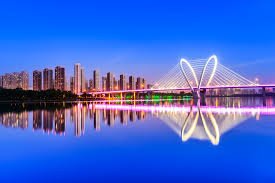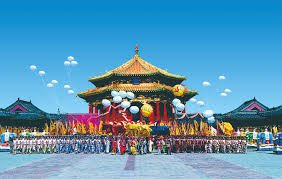At a time when the world is weighed down by diplomatic fatigue and widening geopolitical divides, China, with its Shanghai Cooperation Organization (SCO) presidency, is reshaping the meaning of global engagement not through confrontation but through connecting people-to-people ties from cities, communities, and cultures.
This new direction was on full display in Shenyang, where the 2025 SCO Forum on People-to-People Friendship and the Forum on Friendship Cities were held.

With renewed focus, especially as China is chairing these important regional and global platforms of nearly half of humanity across the region, there is an aim to build a joint story of resilience, reinvention, and relevance in these challenging and troubling times.
Held under the theme “Deepening People-to-People Friendship, Advancing Sustainable Development”, the two forums brought together over 300 representatives from more than 20 countries. Delegates included ministers, city leaders, academics, and civic actors. Their objective was clear, and that was to identify concrete pathways for enhancing trust and cooperation between societies in the SCO region and to institutionalise the growing role of public diplomacy.
Two key documents—the “Consensus on Actions for Sustainable Development of People-to-People Exchanges among SCO Countries” and the “2025 Shenyang Initiative”—laid down a concrete agenda for cities, institutions, and communities to work together across borders. These frameworks have mapped out new avenues of cooperation between museums, schools, universities, sister cities, and civil society groups that could form the social backbone of regional connectivity.

The host city, Shenyang, at first glance impresses with its scale, its modernity, and its sense of movement. But to understand why this city matters, one must look beneath the surface. It is a place where past and future sit side by side in remarkable harmony.
Once the capital of the Qing dynasty and later a stronghold of China’s industrial rise, Shenyang has now reimagined itself as a vibrant urban hub, embracing smart technologies, green development, and cultural preservation all at once. It feels like a city that knows where it’s been and where it wants to go.
And Shenyang lived up to this vision. As the city hosts the forum and global spotlight, it has eventually offered a message of resilience and hope with peace and a shared future. Walking through the city’s streets, one can feel how culture remains alive here. The Shenyang Imperial Palace, though centuries old, still speaks of statecraft and legacy. Nearby, the Fuling Tomb adds solemnity to the urban landscape. Meanwhile, contemporary landmarks like Middle Street, one of China’s oldest commercial zones, or the expansive Shenyang Botanical Garden, show how public life is thriving in spaces that balance leisure with learning.

What has struck the most was how seamlessly Shenyang integrates culinary culture into civic identity. Every meal in this city felt like an event, a gesture of hospitality, and an expression of identity. The flavors spicy, savory, sweet tell the story of a city shaped by Manchu, Korean, Hui, and Han traditions. It was over meals that many cross-cultural conversations deepened. In a way, Shenyang reminds us that diplomacy doesn’t always wear a tie. Sometimes, it smells of fermented tofu and sizzles on a hot plate.
Shenyang also speaks to the economic and technological side of China’s diplomacy. As a key node in China’s Northeast Revitalization Plan, the city is positioning itself as a regional hub for logistics, manufacturing, and digital development. It is this dual character, historical yet high-tec,h that makes it an ideal model for mid-sized cities in SCO countries, many of which are looking for pathways to modernization that don’t erase tradition.
For Pakistan, this forum had another layer of significance. Among the many sister city relationships celebrated at the event, one stood out in particular is that Shenyang’s official partnership with Karachi, Pakistan’s largest city and economic nerve center. The two cities became sister cities in 2021, and that partnership is beginning to bear fruit. Karachi brings its rich diversity, entrepreneurial energy, and maritime legacy to the table. As a city of over 20 million people, Karachi mirrors Shenyang’s own complex identity—at once historic and modern, chaotic yet driven, and deeply connected to the national spirit.
Since the signing of their sister city agreement, Shenyang and Karachi have exchanged delegations, shared expertise in museum development and urban infrastructure, and supported cultural exchange programs. These engagements are helping translate diplomatic ties into real connections between communities, students, and professionals. In the long run, this could lead to collaboration on climate resilience, smart urban planning, and tourism all areas where both cities face shared challenges.

The SCO Public Diplomacy Forum was, in fact, a testing ground for the future of diplomacy, the kind that will matter most in the coming decades. As multilateral forums across the world struggle with geopolitical tensions and strategic divides, platforms like this offer something more durable: human trust. It is through this trust, built slowly and sincerely, that sustainable development and peaceful cooperation become possible.
In many ways, Shenyang embodies China’s people-centered global vision. It is not just exporting products or investments; it is also exporting stories, ideas, and shared experiences. And cities like Shenyang are becoming laboratories for this new kind of engagement—one that is less about abstract principles and more about tangible cooperation.
As someone who has closely followed China’s evolving diplomatic style, I see this as an evolution of the “Beijing Consensus.” Instead of imposing one model, China is now promoting a model of mutual learning, where cities, institutions, and individuals find shared meaning in culture, history, and progress.
Looking ahead, Shenyang has set a high bar not only for how to host an international forum but how to use one’s local identity as a diplomatic asset. Its example should encourage other cities in the SCO region to step forward, share their own stories, and embrace the opportunities that public diplomacy can bring. Because in the end, the bridges we build between people are the most enduring ones.
*The writer is the Founder of Friends of BRI Forum and Advisor to Pakistan Research Center, Hebei Normal University.

Muhammad Asif Noor
*The writer is the Founder Friends of BRI Forum, Advisor to the Pakistan Research Center, Hebei Normal University.



